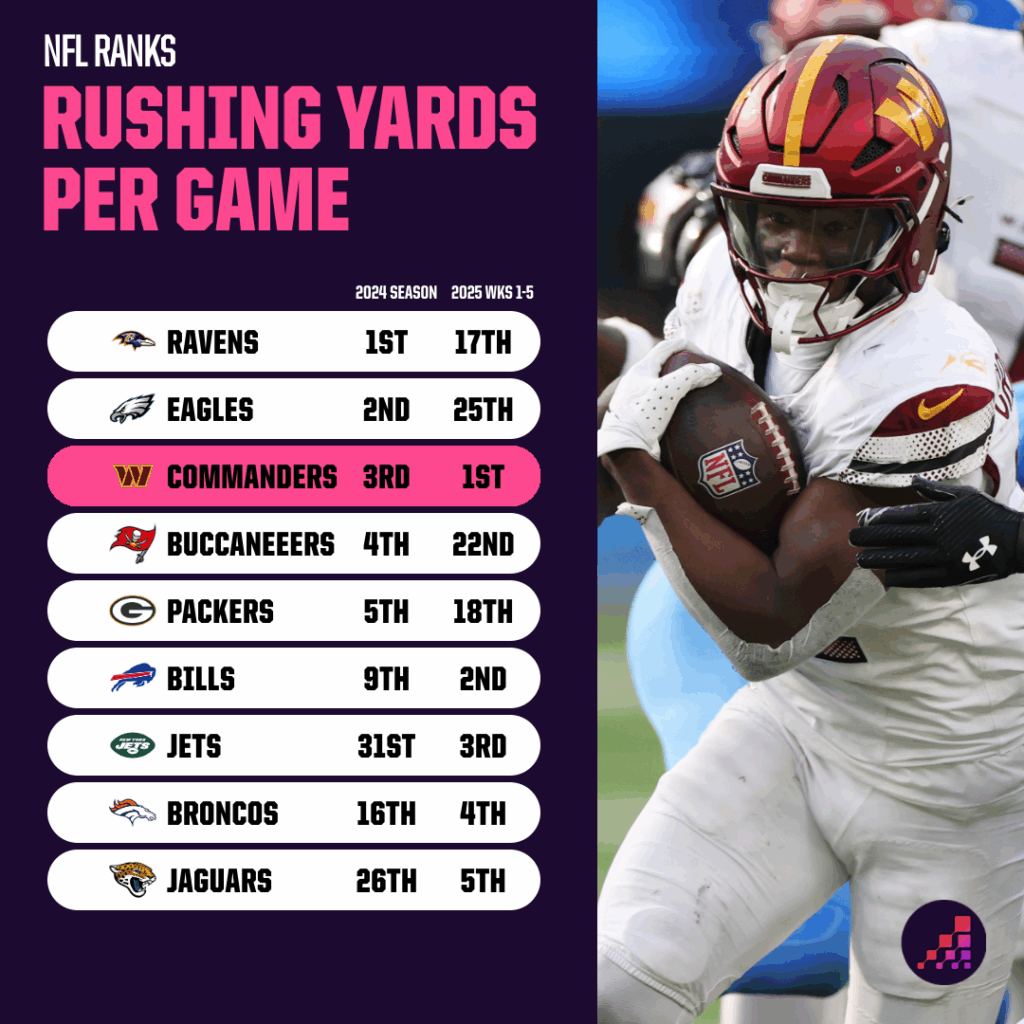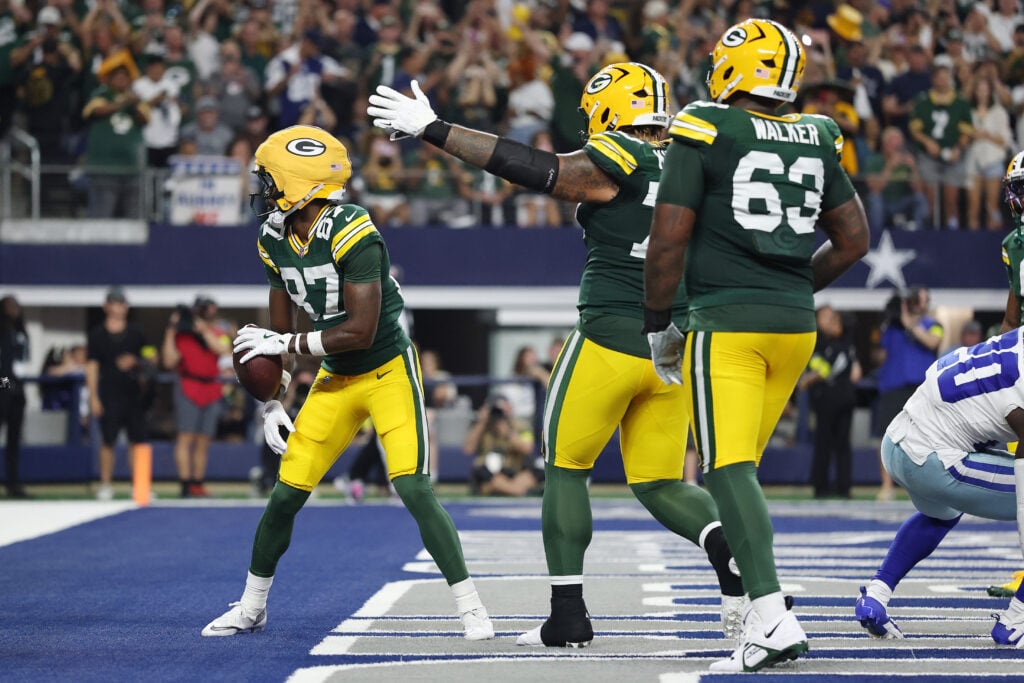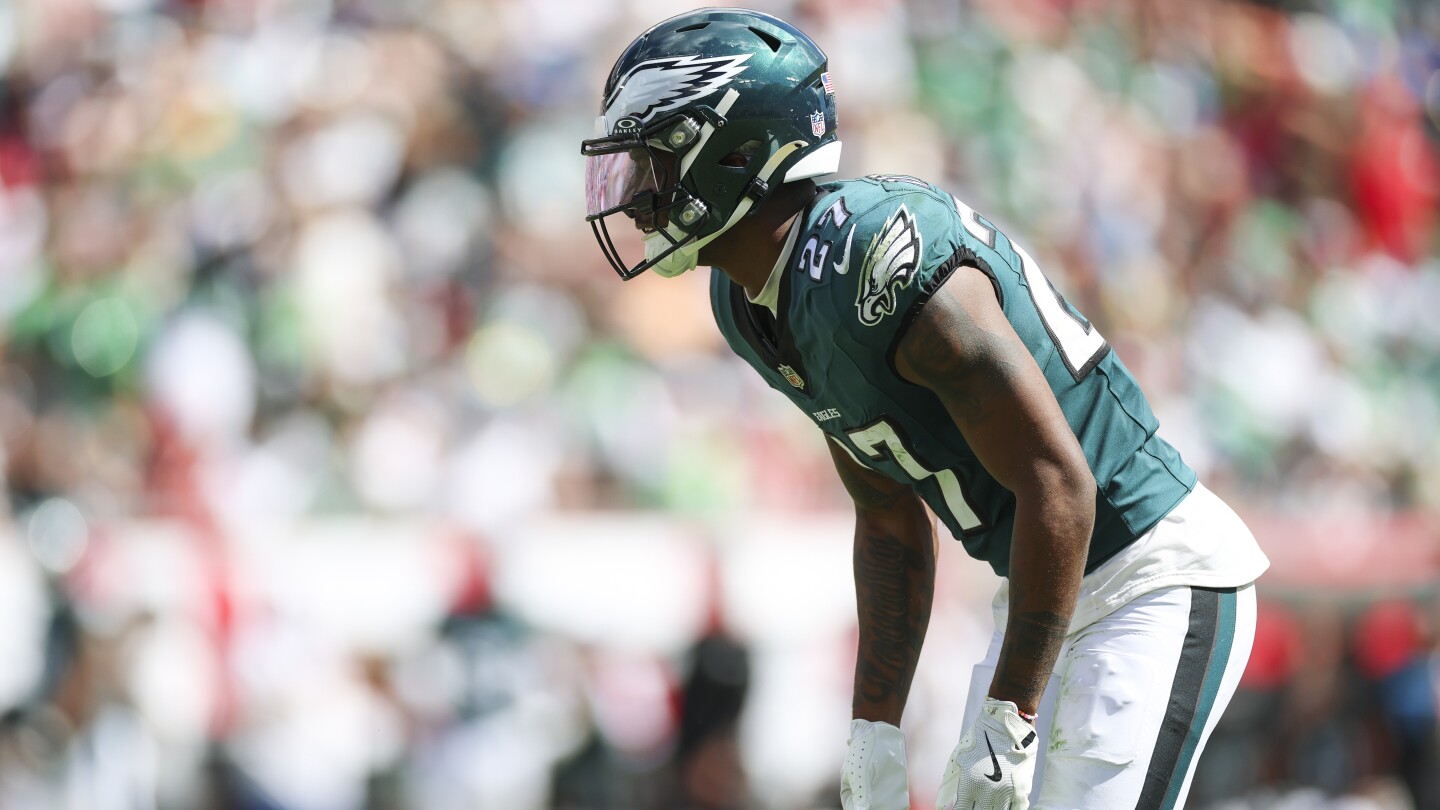
The Vanishing Act of NFL’s Rushing Powerhouses: What’s Behind the Sudden Decline?
Remember when the NFL’s ground game was straightforward—a few powerhouse teams steamrolling defenses and running backs piling up yards like it was second nature? Well, 2025 laughs in the face of that predictability. Unlike last year’s clear dominators on the turf, this season has turned into a kaleidoscope of confusion: no team claiming outright supremacy, no predictable patterns, and backs and offenses blossoming (or sputtering) in ways that leave even the savviest analysts scratching their heads. Think you know who’s leading the charge? Think again. The usual suspects for rushing glory—the Eagles, 49ers, Ravens—aren’t the ones topping efficiency charts. Instead, an unexpected mix of Cowboys, Commanders, Rams, Vikings, and Steelers jostle at the top of run success rate rankings, even while their yardage stats zigzag unpredictably. So what does it mean to be an elite rushing team these days? Is pure yardage a relic of the past or just a misleading highlight reel? Dive in as we unravel this perplexing gridiron paradox. LEARN MORE
Unlike 2024, there’s no single NFL team dominating on the ground this season, no obvious pattern of excellence, and no sure way to predict which backs or offenses will thrive.
If you asked someone to name the best running teams in the NFL, you’d probably hear the usual suspects: the Philadelphia Eagles, San Francisco 49ers, or Baltimore Ravens.
These are teams that have built their offenses around the run, stocked with elite backs and strong offensive lines. But that list would be wrong.
So far, the Dallas Cowboys, Washington Commanders, Los Angeles Rams, Minnesota Vikings and Pittsburgh Steelers lead the league in run success rate – a metric that measures the efficiency of each carry – even though they rank all over the board in rushing yards per game.
The top producers in pure yardage – the Commanders, Buffalo Bills, New York Jets, Denver Broncos and Jacksonville Jaguars – don’t perfectly overlap with success rate rankings, either.
Additionally, the top running back this year, Jonathan Taylor, plays on an Indianapolis Colts team that ranks ninth in rushing yards per game and eighth in run success rate.

The story was simpler a year ago.
In 2024, the top five teams in run success rate all finished in the top 10 in rushing yards per game, and eight of the top 10 teams by success rate also finished in the top 10 for rushing yards. Six of the top 10 rushers played on teams that ranked in the top 10 in success rate.
No such pattern has emerged through five weeks of the 2025 NFL season. And this is all happening without obvious changes at a league-wide level.
Average run success rates are down only slightly (0.2%), heavy boxes are slightly less common (down 0.8%), and yards before first-defender contact are virtually unchanged. Tackling is slightly better this year – 2.96 yards after first contact versus 3.14 in 2024 – but nothing that should cause the huge gaps we’re seeing between success rate and yardage.
Unlike 2024, there’s no single team dominating on the ground, no obvious pattern of excellence, and no sure way to predict which backs or offenses will thrive.
In short, the NFL’s top running teams aren’t necessarily the teams piling up yards. And that raises the question: What does it actually mean to be a good rushing team in 2025?
Why There’s No Elite Running Team in 2025
Looking at team-level metrics, the traditionally elite teams aren’t consistently winning the ground game this year.
Those teams mentioned earlier – the Eagles, 49ers and Ravens – rank 15th, 26th and 31st in run success rate, and 25th, 17th and 29th in rushing yards per game, respectively.
Among teams facing heavy boxes – defenses with more players than blockers – more than half the time, only the Detroit Lions and Ravens average 4.5 or more yards per carry.
Yet, those two rank outside the top 15 in run success rate. So, if we look at the run success rate against heavy boxes, a different collection of teams stands out.

The Rams perform best against heavy boxes, ranking sixth in yards per play and third in run success rate, but they’re 21st in rushing yards per game. Expected run plays – the number of designed runs a team should have – don’t align neatly with success either.
A strategy that worked in 2024, when teams like the Lions, Ravens, and Eagles consistently appeared in the elite category because they dominated on the ground no matter what defenses threw at them, simply isn’t translating in 2025.
A New RB Hierarchy?
The picture gets murkier when evaluating individual running backs.
Comparing running backs’ yards per carry on run disruptions against low yards-before-contact, Rico Dowdle of the Carolina Panthers tops the league among running backs with at least 50 carries. However, 23 of his carries came in Week 5. Remove him, and no running back looks like the best.
Now, if we do the same exercise with yards per carry on run disruptions against a bad box (more defenders than blockers), that paints a better picture of the best running backs in the league this year.

Taylor (94 carries), James Cook (90) and Javonte Williams (79) stand out, along with Omarion Hampton (66), David Montgomery (61) and Kyren Williams (82). But Taylor leads the league in rushing yards per game, with Cook and Williams second and third.
All three average roughly 4 yards per carry despite seeing bad boxes at least 50% of the time. This group also ranks third, 10th and 11th in yards before contact, meaning they’re also getting a nice head of steam before meeting defenders.
It shouldn’t be a surprise that their three teams, the Colts, Bills and Cowboys, are among the better running games in the league – either in success rate, production, or a slight combination of the two.
Meanwhile, previous top backs aren’t repeating past dominance. Derrick Henry and Saquon Barkley, who were the top two rushers in 2024, and Christian McCaffrey, who was No. 1 in 2023 before an injury-riddled 2024, lag behind.
Barkley and McCaffrey, for instance, have baseline yards per carry well below their preseason projections (3.67 vs. 4.76 for Barkley, 3.56 vs. 4.54 for McCaffrey). Henry is slightly better than expected but hampered by a Ravens team that isn’t generating the same level of blocking as in prior seasons.
Age and career wear-and-tear play a role. Henry (31), Barkley (28), and McCaffrey (29) each have between 1,900 and 2,500 career touches. Their yards after contact – a measure of how much they can gain once hit – hover at or below league average and below their career average, limiting production even when the line gives them a chance.
Blocking, though, remains the core issue plaguing these three more than ever before.
The Run-Blocking Issue
The offensive lines and supporting cast are creating bad situations for the best running backs this year. The Ravens and Eagles, both traditionally strong run teams, rank 18th and 20th in run-blocking ELO – a measure that accounts for depth chart and injuries.
Tight ends also matter a lot in the running game. They account for roughly 21% of 1-on-1 blocks on running plays.
In Baltimore, Mark Andrews performs well individually, but the other tight ends rank outside the top 38 in run disruption rate allowed among 66 tight ends with at least 30 run-blocking snaps. Philadelphia’s tight end group fares worse: Dallas Goedert, Grant Calcaterra and Kylen Granson all rank near the bottom in 1-on-1 run-block success among that same group.
San Francisco, which historically relied on George Kittle, hasn’t found comparable replacements. Luke Farrell and Jake Tonges rank 55th and 58th in disruption rate allowed, far below Kittle’s 2024 mark.
This combination of aging backs and inconsistent blocking explains why previous elite rushing teams are no longer guaranteed success. Meanwhile, teams like the Colts and the Bills emerge as unexpectedly strong.
The Changing Nature of the Ground Game
Another factor redefining rushing success in 2025 is how backs are used in the passing game.
Through Week 5 in 2024, running backs with at least 50 carries averaged 52 routes. This year, that number jumps to 67, meaning teams are deploying backs more as pass catchers than ground-dominators.
Additionally, league-wide rushing attempts per game are down from 54.0 in 2024 to 52.5 this season. So, of course, rushing yards per game overall have also fallen from 239.6 last season to 229.5 in 2025.
Another factor to consider is how quarterbacks have become more important for a team’s successful rushing attack. The top four rushing teams in the NFL this season all have quarterbacks who average at least 20 rushing yards per game. So the top rushing teams are producing, but not necessarily from pure running situations.
This matters when it comes to comparing this year to this past year. Lamar Jackson is rushing less for the Ravens, Jalen Hurts isn’t as effective with his legs for the Eagles and both teams are floundering in the ground game.
While we’re only five weeks into the season, establishing a good rushing attack can correlate to postseason appearances.
In 2024, seven of the top 10 teams in run success rate made the playoffs. This year, six of the top 10 through Week 5 have at least a 63% chance to reach the postseason.
So, with no team dominating every category, the strategy for building a good running game varies by team. The NFL’s running game is no longer about domination at the line of scrimmage.
It’s now about balance and versatility.
For more coverage, follow along on social media on Instagram, Bluesky, Facebook and X.
The post Running in Place: Where Have All the NFL’s Elite Rushing Teams Gone? appeared first on Opta Analyst.

































Post Comment